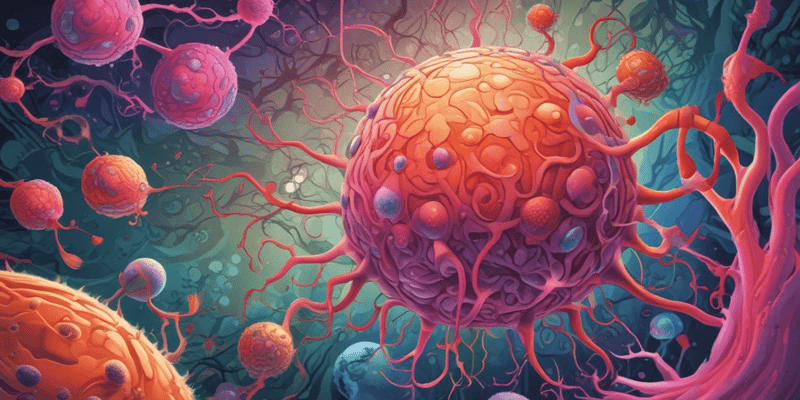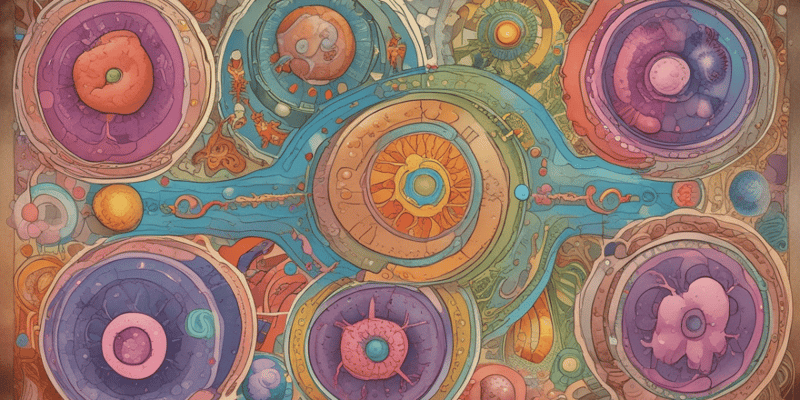Questions and Answers
What is the primary difference between familial and acquired traits?
Familial traits are more frequently found in family members
What is the role of cyclin-dependent kinases (CDKs) in cell cycle regulation?
They are activated by cyclins
What is the main mechanism by which growth factors promote cell growth and survival?
By binding to their receptors and activating signaling pathways
What is the key difference between the Somatic Mutation Theory and the Tissue Organization Field Theory?
Signup and view all the answers
What is the primary function of tumor suppressor genes?
Signup and view all the answers
How do proto-oncogenes become oncogenes?
Signup and view all the answers
What are the primary characteristics of cancer cells?
Signup and view all the answers
How do mutations in oncogenes and tumor suppressor genes contribute to cancer development?
Signup and view all the answers
What was the significance of the National Cancer Act of 1971?
Signup and view all the answers
How has the understanding of cancer evolved from the 1960s to the 2000s?
Signup and view all the answers
What is the definition of hereditary in the context of cancer?
Signup and view all the answers
What is the result of abnormal gene function in cancer development?
Signup and view all the answers
What is the primary mechanism by which cancer cells resist cell death?
Signup and view all the answers
What is the role of TP53 in cellular stress response?
Signup and view all the answers
What is the function of telomerase in cancer cells?
Signup and view all the answers
What is the significance of the angiogenic switch in carcinogenesis?
Signup and view all the answers
What is the role of cadherins and integrins in cancer metastasis?
Signup and view all the answers
What is the significance of chromosomal rearrangements in cancer development?
Signup and view all the answers
What type of sample is naturally rich in dividing cells and may not require mitogens for cytogenetic analysis?
Signup and view all the answers
What is the purpose of blocking cells at the S phase in cytogenetic cultures?
Signup and view all the answers
What is the role of molecular haematology in detecting haematological malignancies?
Signup and view all the answers
What is the most sensitive technique for detecting genetic mutations?
Signup and view all the answers
What is the purpose of temperature and humidity control during slide preparation?
Signup and view all the answers
How do chromosomal translocations contribute to the development of haematological malignancies?
Signup and view all the answers
What is the principle behind the Fluorescence In Situ Hybridization (FISH) technique?
Signup and view all the answers
What types of biological samples are commonly used for cytogenetic analysis in malignant haematology?
Signup and view all the answers
Why are mitogens used in peripheral blood cultures for cytogenetic analysis?
Signup and view all the answers
What is the significance of metaphase in cytogenetic analysis?
Signup and view all the answers
How does conventional cytogenetics contribute to the diagnosis of haematological malignancies?
Signup and view all the answers
What is the role of chromosomal aberrations in haematological malignancies?
Signup and view all the answers
Why is it important to consider the type of chromosomal rearrangement when diagnosing haematological malignancies?
Signup and view all the answers
How does FISH differ from conventional cytogenetics in its approach to detecting genetic abnormalities?
Signup and view all the answers
What is the significance of synchronization in cytogenetic cultures?
Signup and view all the answers
How does molecular haematology complement conventional cytogenetics in the diagnosis of haematological malignancies?
Signup and view all the answers
Why is it important to control temperature and humidity during slide preparation for cytogenetic analysis?
Signup and view all the answers
Study Notes
Cancer Definition and Characteristics
- Cancer is characterized by uncontrolled cell growth, invasion of surrounding tissues, and sometimes metastasis to distant body sites.
- Abnormal gene function leads to dysregulation of cell proliferation, differentiation, and cell death, causing abnormal cell growth and tumor formation.
Cancer Research Timeline
- 1971: The National Cancer Act significantly increased funding for cancer research and established the National Cancer Institute.
- Understanding of cancer has shifted from viewing it as a single disease to recognizing its genetic basis and heterogeneity, with advances in molecular biology and genetics improving diagnosis, treatment, and prevention strategies.
Terminology
- Hereditary: Inherited genetic traits passed from parents to offspring.
- Familial: Traits or conditions that tend to occur more frequently in family members than in the general population, possibly due to shared genetic and environmental factors.
- Acquired: Characteristics or conditions developed during an individual's life rather than being inherited.
- Transcription: The process of copying a segment of DNA into RNA.
- Dysregulation: Abnormality or impairment in the regulation of a metabolic, physiological, or biological process.
- Proliferation: The rapid multiplication of cells.
Cell Cycle Regulation
- Cyclins regulate the progression of cells through the cell cycle by activating cyclin-dependent kinases (CDKs).
- Growth factors and their receptors influence signal transduction pathways, promoting cell proliferation, survival, and differentiation.
Carcinogenesis
- Carcinogenesis is the process by which normal cells are transformed into cancer cells, involving genetic mutations and epigenetic alterations that disrupt normal cell regulatory mechanisms.
- Knudson's Two-Hit Hypothesis states that cancer results from the accumulation of two genetic mutations or "hits" in a tumor suppressor gene.
Theories of Carcinogenesis
- Somatic Mutation Theory (SMT): Cancer results from accumulated genetic mutations in somatic cells.
- Tissue Organization Field Theory (TOFT): Cancer is a problem of tissue organization, where the microenvironment and cell interactions play a critical role.
- Multi-Step Nature of Cancer: Cancer involves the accumulation of multiple genetic alterations over time, leading to the progression from normal cells to malignant cancer cells.
Cancer Stem Cell Theories
- Cancer stem cells are a subset of tumor cells with self-renewal and differentiation capabilities, contributing to tumor growth, recurrence, and resistance to treatments.
- Proto-oncogenes promote cell growth and division, and can become oncogenes when mutated. Tumor suppressor genes inhibit cell growth and division, and help prevent cancer.
Mechanisms of Oncogene Activation
- Proto-oncogenes can become oncogenes through mutations, gene amplification, chromosomal translocations, and increased expression.
- Gene amplification of HER2 in breast cancer leads to overexpression of the HER2 protein, driving excessive cell proliferation.
Tumor Suppressor Genes
- Tumor suppressor genes regulate cell cycle progression, promote apoptosis, repair DNA damage, and maintain genomic stability.
- TP53 is involved in DNA repair, apoptosis, and cell cycle regulation, and mutations are associated with a wide range of cancers.
Hallmarks of Cancer
- Cancer cells acquire six biological capabilities: sustaining proliferative signaling, evading growth suppressors, resisting cell death, enabling replicative immortality, inducing angiogenesis, and activating invasion and metastasis.
- Cancer cells sustain growth signaling and evade growth suppressors through mutations in growth factor receptors or downstream signaling pathways, and inactivating tumor suppressor genes or bypassing growth-inhibitory signals.
Resisting Cell Death
- Cancer cells resist apoptosis by upregulating anti-apoptotic proteins or downregulating pro-apoptotic proteins.
- TP53 plays a key role in promoting apoptosis in response to cellular stress, and its mutation can prevent apoptosis.
Enabling Replicative Immortality
- Cancer cells bypass senescence by reactivating telomerase, maintaining telomere length, and avoiding telomere shortening.
- Telomeres protect chromosome ends from degradation, and telomerase extends telomeres, allowing cancer cells to divide indefinitely.
Inducing Angiogenesis
- Angiogenesis provides tumors with oxygen and nutrients necessary for growth, and is regulated by factors like VEGF.
- Factors like hypoxia, oncogene activation, and loss of tumor suppressors can trigger the angiogenic switch.
Activating Invasion and Metastasis
- Changes in cell adhesion molecules like cadherins and integrins facilitate cancer metastasis.
- Tissue invasion and metastasis are critical steps in cancer progression, leading to the spread of cancer to other parts of the body.
Importance of Cancer Genetics in Malignant Haematology
- Genetic mutations and epigenetic changes contribute to malignant haematology by disrupting normal blood cell development.
- Chromosomal rearrangements can create fusion genes, activate oncogenes, or inactivate tumor suppressor genes, driving cancer development.
Laboratory Investigations in Haematological Malignancies
- Laboratory investigations include complete blood count (CBC), bone marrow biopsy, cytogenetics, flow cytometry, molecular testing (PCR, FISH), and immunohistochemistry.
- Samples required for malignant cytogenetics include bone marrow aspirates, peripheral blood, and lymph node biopsies.
Principles of Cell Culture
- Mitogens are used in normal peripheral blood cultures to stimulate cell division for cytogenetic analysis.
- Bone marrow samples naturally contain dividing cells, while leukemic blood samples may require mitogens to stimulate cell division.
Principles of Conventional Cytogenetic Culture
- Blocking cells at the S phase ensures synchronization, allowing for the collection of a high number of metaphase cells for analysis.
- Mitotic arrest is achieved using chemicals like colchicine or colcemid, which inhibit spindle formation and trap cells in metaphase.
Harvesting and Slide Preparation
- Steps involved in preparing slides for cytogenetic analysis include cell culture, harvesting cells, hypotonic treatment, fixation, slide preparation, and staining.
- Temperature and humidity control are important during slide making to prevent artifacts.
The Role of Molecular Haematology
- Molecular haematology identifies genetic mutations and markers, aiding in diagnosis, prognosis, and monitoring treatment response.
- PCR is the most sensitive technique for detecting mutations, followed by FISH and then conventional cytogenetics.
The Role of Clinical Cytogenetics in Haematological Malignancies
- Clinical cytogenetics helps confirm the diagnosis of haematological malignancies by identifying chromosomal abnormalities.
- Stratifying patients based on cytogenetic analysis allows for personalized treatment plans and improves clinical trial design.
Chromosomal Rearrangements
- Types of chromosomal rearrangements commonly observed in haematological malignancies include translocations, inversions, deletions, and duplications.
- Chromosomal translocations can create fusion genes or place oncogenes under the control of strong promoters, leading to their overexpression and oncogenic activity.
FISH Principles
- FISH uses fluorescent probes that bind to specific DNA sequences, allowing for the visualization and localization of genetic abnormalities in cells.
- DNA probes labeled with fluorescent dyes hybridize to complementary sequences in the genome, highlighting specific regions for analysis under a fluorescence microscope.
Studying That Suits You
Use AI to generate personalized quizzes and flashcards to suit your learning preferences.




